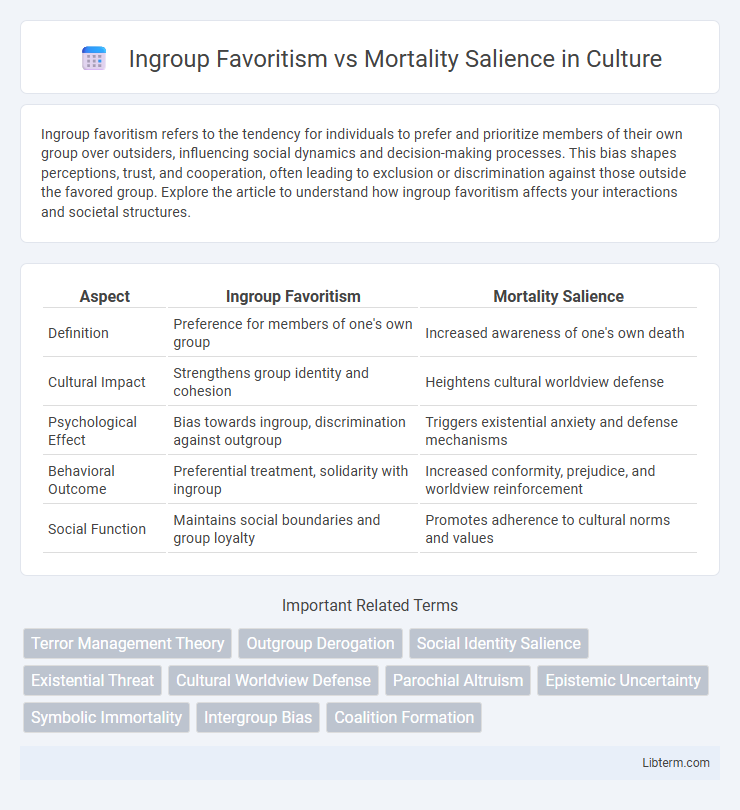Ingroup favoritism refers to the tendency for individuals to prefer and prioritize members of their own group over outsiders, influencing social dynamics and decision-making processes. This bias shapes perceptions, trust, and cooperation, often leading to exclusion or discrimination against those outside the favored group. Explore the article to understand how ingroup favoritism affects your interactions and societal structures.
Table of Comparison
| Aspect | Ingroup Favoritism | Mortality Salience |
|---|---|---|
| Definition | Preference for members of one's own group | Increased awareness of one's own death |
| Cultural Impact | Strengthens group identity and cohesion | Heightens cultural worldview defense |
| Psychological Effect | Bias towards ingroup, discrimination against outgroup | Triggers existential anxiety and defense mechanisms |
| Behavioral Outcome | Preferential treatment, solidarity with ingroup | Increased conformity, prejudice, and worldview reinforcement |
| Social Function | Maintains social boundaries and group loyalty | Promotes adherence to cultural norms and values |
Understanding Ingroup Favoritism
Ingroup favoritism refers to the tendency of individuals to prefer and prioritize members of their own group over outsiders, influencing social dynamics and decision-making processes. This bias often manifests through enhanced trust, cooperation, and positive evaluations toward ingroup members, which can intensify under conditions of mortality salience, where awareness of death heightens group cohesion. Understanding ingroup favoritism involves analyzing psychological mechanisms such as social identity theory and terror management theory, highlighting how existential threats amplify group loyalty and discriminatory behavior.
Defining Mortality Salience
Mortality salience refers to the awareness and recognition of one's own inevitable death, which significantly influences human behavior and cognition. This heightened consciousness of mortality often triggers psychological defense mechanisms, including increased ingroup favoritism as individuals seek security and identity affirmation within their social groups. Research in social psychology demonstrates that mortality salience can intensify group biases, reinforcing loyalty and preference for ingroup members while potentially fostering intergroup hostility.
Psychological Roots of Group Loyalty
Ingroup favoritism stems from deep psychological roots tied to evolutionary survival mechanisms and the need for social identity, which bolster group loyalty by enhancing feelings of belonging and security. Mortality salience intensifies these effects by triggering existential anxiety, leading individuals to cling more strongly to their ingroups as a defense against death-related fears. This interplay highlights how awareness of mortality amplifies group cohesion and biases, reinforcing psychological drives for protection, acceptance, and meaning within social groups.
How Mortality Salience Shapes Social Behavior
Mortality salience intensifies ingroup favoritism by heightening individuals' desire for social belonging and security amid existential threats. This psychological state activates defense mechanisms that amplify loyalty and preferential treatment towards one's ingroup while often increasing prejudice or exclusion of outgroups. Research in social psychology demonstrates that awareness of mortality significantly influences group dynamics, driving behaviors aimed at reinforcing cultural values and group cohesion.
Interplay Between Fear of Death and Ingroup Bias
Mortality salience intensifies ingroup favoritism by heightening awareness of death, leading individuals to seek comfort in familiar social groups. This fear of mortality triggers stronger ingroup bias as a psychological defense mechanism, enhancing group identity and cohesion. Research indicates that when mortality is salient, people display increased preference for ingroup members while showing greater prejudice toward outgroup members to reinforce symbolic immortality.
Experimental Evidence Linking Mortality Salience and Favoritism
Experimental evidence consistently demonstrates that mortality salience intensifies ingroup favoritism by heightening individuals' need for social connectedness and symbolically reinforcing group identity. Studies employing mortality reminders reveal increased preferential treatment toward ingroup members, such as allocating more resources or exhibiting greater trust and cooperation. Neuroimaging results further support these findings by showing elevated activity in brain regions associated with reward and threat detection when participants face mortality cues and engage in ingroup-favoring behaviors.
Societal Impacts of Ingroup Preference Under Threat
Ingroup favoritism intensifies when mortality salience is heightened, leading individuals to strongly prefer their own group as a psychological defense against existential threats. This heightened ingroup preference can exacerbate societal divisions, increasing discrimination and reducing cooperation between groups during times of crisis or perceived danger. Such dynamics contribute to social polarization and hinder collective responses to shared challenges like pandemics or conflicts.
Reducing Bias: Strategies Amid Mortality Awareness
Mortality salience intensifies ingroup favoritism by heightening existential anxiety and promoting reflexive group loyalty as a defense mechanism. Strategies to reduce bias under mortality awareness include promoting inclusive identities that transcend group boundaries and fostering perspective-taking to increase empathy for outgroup members. Implementing mindfulness practices and enhancing intergroup contact can mitigate defensive reactions, encouraging more equitable social interactions despite mortality concerns.
Cultural Differences in Mortality Salience Response
Cultural differences significantly influence responses to mortality salience, with collectivist societies exhibiting stronger ingroup favoritism as a defense mechanism against existential threats. Research shows that individuals from collectivist cultures prioritize group harmony and social connectedness, intensifying ingroup favoritism when reminded of mortality. In contrast, individualistic cultures demonstrate a more self-focused response, emphasizing personal achievements and values under mortality salience conditions.
Future Directions in Ingroup Favoritism Research
Future directions in ingroup favoritism research explore the impact of mortality salience on intergroup dynamics, emphasizing neurocognitive mechanisms underlying threat responses and identity protection. Emerging studies investigate longitudinal effects of existential threats on social cohesion and bias, integrating cross-cultural analyses to understand variability in ingroup favoritism. Advancements in virtual reality and neuroscientific tools offer novel methodologies to simulate mortality salience and measure behavioral and neural correlates of ingroup favoritism.
Ingroup Favoritism Infographic

 libterm.com
libterm.com